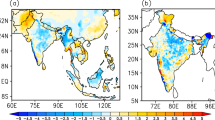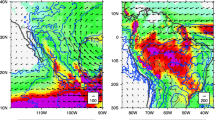Abstract
In this study the potential future changes in different aspects of the Indian summer monsoon associated with a global warming of 2°C with respect to pre-industrial times are assessed, focussing on the role of the different mechanisms leading to these changes. In addition, these changes as well as the underlying mechanisms are compared to the corresponding changes associated with a markedly stronger global warming exceeding 4.5°C, associated with the widely used SRES A1B scenario. The study is based on two sets of four ensemble simulations with the ECHAM5/MPI-OM coupled climate model, each starting from different initial conditions. In one set of simulations (2020–2200), greenhouse gas concentrations and sulphate aerosol load have been prescribed in such a way that the simulated global warming dioes not exceed 2°C with respect to pre-industrial times. In the other set of simulations (1860–2200), greenhouse gas concentrations and sulphate aerosol load have been prescribed according to observations until 2000 and according to the SRES A1B scenario after 2000. The study reveals marked changes in the Indian summer monsoon associated with a global warming of 2°C with respect to pre-industrial conditions, namely an intensification of the summer monsoon precipitation despite a weakening of the large-scale monsoon circulation. The increase in the monsoon rainfall is related to a variety of different mechanisms, with the intensification of the atmospheric moisture transport into the Indian region as the most important one. The weakening of the large-scale monsoon circulation is mainly caused by changes in the Walker circulation with large-scale divergence (convergence) in the lower (uppper) troposphere over the Indian Ocean in response to enhanced convective activity over the Indian Ocean and the central and eastern Pacific and reduced convective activity over the western tropical Pacific. These changes in the Walker circulation induce westerly (easterly) wind anomalies at lower (upper) level in the Indian region. The comparison with the changes in the Indian summer monsoon associated with a global warming of 4.5°C reveals that both the intensification of the monsoon precipitation and the weakening of the large-scale monsoon circulation (particularly in the lower troposphere) are relatively strong (with respect to the magnitude of the projected global warming by the end of the twentieth century for the two scenarios) in the scenario with a global warming of 2°C. The relatively strong intensification of the monsoon rainfall is related to rather strong increases in evaporation over the Arabian Sea and the Bay of Bengal, while a rather weak amplification of the meridional temperature gradient between the Indian Ocean and the land areas to the north contributes to the relatively strong reduction of the large-scale monsoon flow.
















Similar content being viewed by others
References
Annamalai H, Hamilton K, Sperber KR (2007) The south Asian summer monsoon and its relationship with ENSO in the IPCC AR4 simulations. J Clim 20:1071–1092
Ashfaq M, Shi Y, Tung W-W, Trapp RJ, Gao X, Pal JS, Diffenbaugh NS (2009) Suppression of south Asian summer monsoon precipitation in the 21st century. Geophys Res Lett 36. doi:10.1029/2008GL036500
Boucher O, Lohmann U (1995) The sulphate-CCN-cloud albedo effect: a sensitivity study using two general circulation models. Tellus 47B:281–300
Chandrasekar A, Kitoh A (1998) Impact of localized sea surface temperature anomalies over the equatorial Indian Ocean on the Indian summer monsoon. J Meteor Soc Japan 76:841–853
Cherchi A, Alessandri A, Masina S, Navarra A (2010) Effect of increasing CO2 levels on monsoons. Clim Dyn. doi:10.1007/s00382-010-0801-7
Christensen JH, 16 co-authors (2007) Regional climate projections. In: Solomon S, Qin D, Manning M, Chen Z, Marquis M, Averyt KB, Tignor M, Miller HL (eds), Climate Change 2007: the physical science basis. Cambridge University Press, Cambridge, pp 847–940
Cruz RV, 9 co-authors (2007) Asia. In: Parry ML, Canziani OF, Palutikof JP, van der Linden PJ, Hanson CE (eds), Climate Change 2007: impacts, adaptation and vulnerability. Cambridge University Press, Cambridge, pp 469–506
Dairaku K, Emori S (2006) Dynamic and thermodynamic influences on intensified daily rainfall during the Asian summer monsoon under doubled atmospheric CO2 conditions. Geophys Res Lett 33. doi:10.1029/2005GL024754
Douville H, Royer J-F (1996) Sensitivity of the Asian summer monsoon to an anomalous Eurasian snow cover within the Météo-France GCM. Clim Dyn 12:449–466
Douville H, Royer J-F, Polcher J, Cox P, Gedney N, Stephenson DB, Valdes PJ (2000) Impact of doubling CO2 on the Asian summer monsoon: robust versus model-dependent responses. J Meteorol Soc Japan 78:421–439
Douville H, Chauvin F, Planton S, Royer J-F, Salas-Mélia D, Tyteca S (2002) Sensitivity of the hydrological cycle to increasing amounts of greenhouse gases and aerosols. Clim Dyn 20:45–68
Ferranti L, Molteni F (1999) Ensemble simulations of Eurasian snow-depth anomalies and their influence on the summer Asian monsoon. Quart J Roy Meteorol Soc 125:2597–2610
Gadgil S, Rupa Kumar K (2006) The Asian monsoon–agriculture and economy. In: Wang B (ed) The Asian monsoon. Springer, Berlin, pp 651–683
Gill AE (1980) Some simple solutions to heat induced tropical circulations. Quart J Roy Meteorol Soc 106:447–462
Goswami BN, Krishnamurthy V, Annamalai H (1999) A broad-scale circulation index for the interannual variability of the Indian summer monsoon. Quart J Roy Meteorol Soc 125:611–633
Hess M, Koepke P, Schult I (1998) Optical properties of aerosols and clouds: the software package OPAC. Bull Amer Meteor Soc 79:831–844
Hu Z-Z, Latif M, Roeckner E, Bengtsson L (2000) Intensified Asian summer monsoon and its variability in a coupled model forced by increasing greenhouse gas concentrations. Geophys Res Lett 27:2681–2684
Joseph PV, Eischeid JK, Pyle RJ (1994) Interannual variability of the onset of the Indian summer monsoon and its association with atmospheric features, El Niño, and sea surface temperature anomalies. J Clim 7:81–105
Jungclaus JH, Botzet M, Haak H, Keenlyside N, Luo JJ, Latif M, Marotzke J, Mikolajewicz U, Roeckner E (2006) Ocean circulation and tropical variability in the coupled model ECHAM5/MPI-OM. J Clim 19:3952–3972
Kitoh A, Yukimoto S, Noda A, Montoi T (1997) Simulated changes in the Asian summer monsoon at times of increased atmospheric CO2. J Meteorol Soc Japan 75:1019–1031
Kripalani RH, Kulkarni A (1999) Climatology and variability of historical Soviet snow depth data: some new perspectives in snow–Indian monsoon teleconnections. Clim Dyn 15:475–489
Kripalani RH, Oh JH, Kulkarni A, Sabade SS, Chaudhari HS (2007) South Asian summer monsoon precipitation variability: coupled climate model simulations and projections under IPCC AR4. Theor Appl Climatol 90:133–159
Krishnamurti TN, Ramanathan Y (1982) Sensitivity of the monsoon onset to differential heating. J Atmos Sci 39:1290–1306
Lu J, Vecchi GA, Reichler T (2007) Expansion of the Hadley cell under global warming. Geophys Res Lett 34. doi:10.1029/2006GL028443
Marsland SJ, Haak H, Jungclaus JH, Latif M, Röske F (2003) The Max-Planck-Institute global ocean/sea ice model with orthogonal curvilinear coordinates. Ocean Modell 5:91–127
May W (2004a) Simulation of the variability and extremes of daily rainfall during the Indian summer monsoon for present and future times in a global time-slice experiment. Clim Dyn 22:183–204
May W (2004b) Potential future changes in the Indian summer monsoon due to greenhouse warming: analysis of mechanisms in a global time-slice experiment. Clim Dyn 22:339–414
May W (2008) Climatic changes associated with a global “2°C-stabilization” scenario simulated by the ECHAM5/MPI-OM coupled climate model. Clim Dyn 31:283–313
Meehl GA, Arblaster JM (2002) Indian monsoon GCM sensitivity experiments testing tropospheric biannual oscillation transition conditions. J Clim 15:923–944
Meehl GA, Arblaster JM (2003) Mechanisms for projected future changes in South Asian monsoon precipitation. Clim Dyn 21:659–675
Meehl GA, 13 co-authors (2007) Global climate projections. In: Solomon S, Qin D, Manning M, Chen Z, Marquis M, Averyt KB, Tignor M, Miller HL (eds), Climate Change 2007: the physical science basis. Cambridge University Press, Cambridge, pp 747–845
Meehl GA, Washington WM (1993) South Asian summer monsoon variability in a model with a doubled atmospheric carbon dioxide concentration. Science 260:1101–1104
Meehl GA, Arblaster JM, Collins WD (2008) Effects of black carbon aerosols on the Indian monsoon. J Clim 21:2869–2882
Mitchell TD (2003) Pattern scaling. An examination of the accuracy of the technique of describing future climates. Clim Change 60:217–242
Mitchell JFB, Johns TC, Eagles M, Ingram WJ, Davis RA (1999) Towards the construction of climate change scenarios. Clim Change 41:547–581
Moss RH, 18 co-authors (2010) The next generation of scenarios for climate change research and assessment. Nature 463:747–756
Nakićenović N, 27 co-authors (2000) Emission scenarios, a special report of Working Group III of the Intergovernmental Panel on Climate Change. Cambridge University Press, Cambridge, pp 599
Parry M, Canziani O, Palutikof J, van der Linden P, Hanson C (eds) (2007) Climate Change 2007: impacts adaptation and vulnerability. Cambridge University Press, Cambridge, p 976
Parthasarthy B, Sontakke NA, Munot AA, Kothawale DR (1987) Droughts/floods in the summer monsoon season over different meteorological subdivisions of India for the period 1871–1984. J Climatol 7:57–70
Räisänen J, Hansson U, Ullerstig A, Döscher R, Graham LP, Jones C, Meier HEM, Samuelson P, Willén U (2004) European climate in the late twenty-first century: regional simulations with two driving global models and two forcing scenarios. Clim Dyn 22:13–31
Roeckner E, 13 co-authors (2003) The atmospheric general circulation model ECHAM5. Part I: model description. MPI-Report 349, pp 127
Roeckner E, Brokopf R, Esch M, Giorgetta M, Hagemann S, Kornblüh L, Manzini E, Schlese U, Schulzweida U (2006) Sensitivity of simulated climate to horizontal and vertical resolution in the ECHAM5 atmosphere model. J Clim 19:3771–3791
Sankar-Rao M, Lau MK, Yang S (1996) On the relationship between Eurasian snow cover and the Asian summer monsoon. Int J Climatol 16:605–616
Schellnhuber HJ, Nakićenović NJ, Wigley T, Yohe G (eds) (2006) Avoiding dangerous climate change. Cambridge University Press, Cambridge, p 392
Sontakke NA, Plant GB, Singh N (1993) Construction of all India rainfall series for the period 1844–1991. J Clim 6:1807–1811
Stowasser M, Annamalai H, Hefner J (2009) Response of the Asian summer monsoon to global warming: mean and synoptic systems. J Clim 22:1014–1036
Tanaka HL, Ishizaki N, Kitoh A (2004) Trend and interannual variation of Walker, monsoon and Hadley circulations defined by velocity potential in the upper troposphere. Tellus A 56:250–269
Taylor KE, Stouffer RJ, Meehl GA (2009) A summary of the CMIP5 experiment design. http://www.cmip-pcmdi.llnl.gov/cmip5
Turner AG, Inness PM, Slingo JM (2007) The effect of doubled CO2 and model basic state biases on the monsoon-ENSO system Part A: mean response and interannual variability. Quart J Roy Meteorol Soc 135:1–20
Twomey SA (1977) The influence of pollution on the shortwave albedo of clouds. J Atmos Sci 34:1149–1152
Ueda H, Iwai A, Kuwako K, Hori ME (2006) Impact of anthropogenic forcing on the Asian summer monsoon as simulated by 8 GCMs. Geophys Res Lett 33. doi:10.1029/2005GL025336
United Nations (1992) United Nations Framework Convention on Climate Change (UNFCCC). http://www.unfccc.int
Vecchi GA, Soden BJ (2007) Global warming and the weakening of the tropical circulation. J Clim 20:4316–4340
Webster PJ (1983) The large-scale structure of the tropical atmosphere. In: Hoskins B, Pierce R (eds) Large Scale Dynamical Processes. Academic Press, San Diego, pp 235–276
Webster PJ (2006) The coupled monsoon system. In: Wang B (ed) The Asian monsoon. Springer, Berlin, pp 3–66
Webster PJ, Yang S (1992) Monsoon and ENSO: selectively interactive systems. Quart J Roy Meteorol Soc 118:877–926
Webster PJ, Magaña VO, Palmer TN, Shukla J, Tomas RA, Yanai M, Yasunari T (1998) Monsoon: processes, predictability, and prospects for prediction. J Geophys Res 103:14451–14510
Acknowledgments
This work was supported by the Danish Ministry of Climate and Energy and the European Commission through the ENSEMBLES project under contract no. GOCE-CT-2003-505539. I thank the two anonymous reviewers for their helpful comments and suggestions that helped to improve the manuscript.
Author information
Authors and Affiliations
Corresponding author
Rights and permissions
About this article
Cite this article
May, W. The sensitivity of the Indian summer monsoon to a global warming of 2°C with respect to pre-industrial times. Clim Dyn 37, 1843–1868 (2011). https://doi.org/10.1007/s00382-010-0942-8
Received:
Accepted:
Published:
Issue Date:
DOI: https://doi.org/10.1007/s00382-010-0942-8




